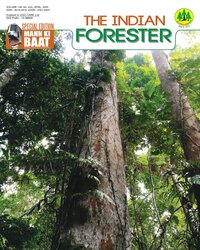Assessment of Impact on Water Quality of Aquatic Resources Due to Idol Immersion
DOI:
https://doi.org/10.36808/if/2023/v149i4(A)/169908Keywords:
Eco-Friendly Materials, PoP, Physico-Chemical Parameters and Heavy Metals.Abstract
India is known for its rich culture and festivals. Festivals like Ganeshotsav and Durga Puja hold an Integral place In Indian culture. The puja and celebrations are followed by the immersion o f Idols In waterbodies. Central Pollution Control Board (CPCB) prepared guidelines for idol immersion in consultation with stakeholders to ensure safe and eco-friendly disposal of idols for conservation of natural resources. The revised guidelines are presently under Implementation by respective States/ UTs. To assess the impact of Idol immersion and implementation of CPCB guidelines, water quality monitoring of respective water bodies was carried out during pre and post immersion. The case study of river Yamuna in Delhi stretch indicated an increase in Dissolved Oxygen (DO) levels of 24% In 2021 and 137.7% in 2022 post immersion. Concentration of Bio-Chemical Oxygen Demand (BOD) also showed a reduction of 32.4% in 2021 and 34.9% in 2022. in 2019, at immersion sites on river Yamuna In Delhi, maximum concentration of BOD of 40 mg/L was observed which has been reduced to 22 mg/L in 2022. In terms o f other physico-chemical and heavy metal parameters, significant reduction in concentration levels is observed. Similar studies were carried out in other states. Improvement In terms of creation of artificiai ponds/designated ghats for immersion of Idols by local authorities. Initiatives for mass awareness programmes for use of eco-friendly materials observed, in the 23rd episode of Mann Ki Baat aired on August 28th, 2016, Hon'bie Prime Minister also emphasized on the use of clay in making of Ganesh and Durga idols to prevent pollution o f rivers, ponds and provide protection to aquatic life. The present paper is a compilation of case studies to assess impact of the guidelines for immersion of Idols on the waterbodies, in terms of various parameters including physico-chemical and heavy metal on pre and post idol immersion activities.References
Bhattacharya Sayan, Arpita Bera, Abhishek Dutta and Uday Chand Ghosh (2014). Effects of idol immersion on the water quality of Indian water bodies: Environmental health perspectives. International Letters of Chemistry, Physics and Astronomy, 234-263.
CPCB (2020). Revised Guidelines for Idol Immersion, Central Pollution Control Board, https://cpcb.nic.in accessed on 20/04/2023
Das Kaushik Kumar, Tanuja Panigarhi and R.B. Panda (2012). Idol Immersion Activities cause Metal Contamination in River Budhabalanga, Balasore, Odisha, India. International Journal of Modern Engineering Research (IJMER), 06:4540-4542.
Joshi Akshay, Niharika Shivhare, Naman Patel and Shifa Khan (2017). Surface water quality assessment during idoi immersion. International Journal of Engineering Sciences and Research, 413-419.
Ruhi Gupta, Runak Jana, Sumit Kumar, Susmita Bakshi (2020). Water pollution due to idol immersion in water bodies of Kolkata. International Research Journal of Engineering and Technology (IRJET), 03:5423-5427.
Ujjania N.C., Chaitali and A. Mistry (2012). Environmental Impact of Idol Immersion on Tapi River (India). International Journal of Geology, Earth and Environmental Sciences, 02:11Â16.
Downloads
Downloads
Published
How to Cite
Issue
Section
License
Unless otherwise stated, copyright or similar rights in all materials presented on the site, including graphical images, are owned by Indian Forester.





